The COVID-19 crisis has caused unprecedented job losses across Canada, and B.C. has not been spared. Between February and May almost 590,000 B.C. workers lost their jobs or more than half their hours — 23 per cent of all workers employed in February. Despite a slight recovery of jobs in May and June, the scale of job losses and disruptions far exceed those seen in typical recessions.
While all sectors of the economy have been affected, the labour market hit has worsened existing inequalities.
Lower-paid workers in part-time, temporary and more precarious jobs were much more likely to lose their jobs or the majority of their hours than those in higher-paid, more secure jobs. Younger workers, recent immigrants, women — particularly mothers of younger children — and workers who lack the protection of a union were hardest hit.
Understanding the highly unequal impacts of the current crisis on B.C. workers is crucial in designing effective and equitable solutions as we look to rebuild the provincial economy. Public investments in the recovery must promote job creation in sectors and positions that employ the types of workers who suffered the worst labour market impacts.
This will require significant investments in programs that enable all British Columbians to fully participate in the economy by expanding access to affordable, safe child care and seniors care, and by enabling unemployed and underemployed workers to access low-cost skill development opportunities.
The following eight charts show just how unequal the jobs impacts of the pandemic have been in B.C.
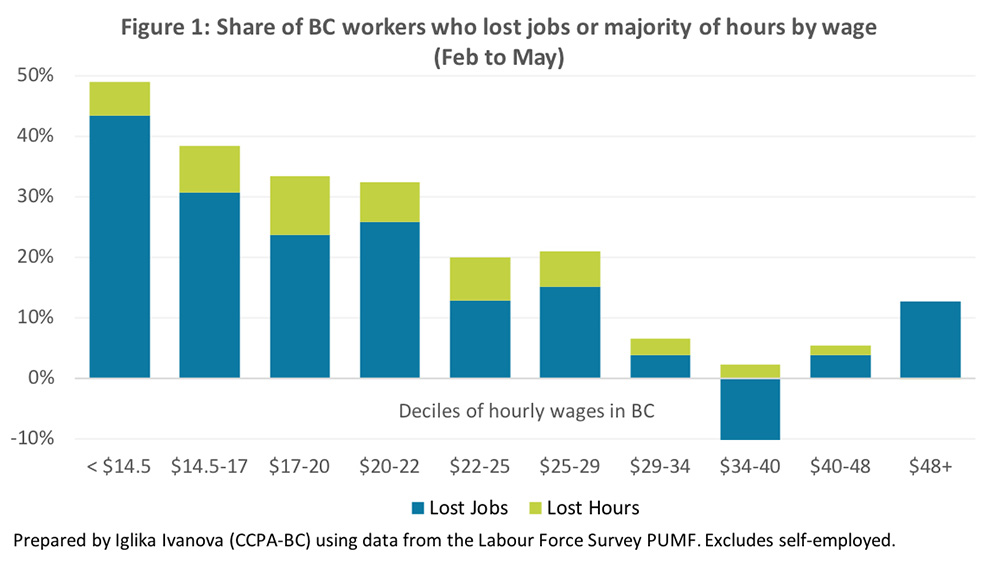
1. Low-wage workers were significantly more likely to lose their jobs or the majority of their hours.
The job losses and cuts in hours resulting from the pandemic have been felt across the income ladder. However, they have been far more severe for lower-wage workers. Half of B.C. workers who earned minimum wage or slightly above (the bottom wage 10 per cent) lost their jobs or hours, compared to fewer than one in 10 among higher-paid workers ($29 to $48 per hour).
Half of all B.C.’s job losses were concentrated in the lowest-paid 20 per cent of workers (under $17 per hour). These workers are disproportionately women, racialized and Indigenous and recent immigrants. Only four per cent of BC’s total job losses were shouldered by those in the top 40 per cent of the wage distribution (earning over $29 per hour).
The heavy impact on workers at the lower end of the income ladder isn’t surprising given the industries most disrupted by the pandemic. Three-quarters of those who lost their jobs between February and May were employed in one of five industries: accommodation and food services, retail, construction, information, culture and recreation and a sector called “other services,” which includes personal services, repair and maintenance, domestic workers (including nannies, cleaners and gardeners) and most charities and non-profits. In addition, 43 per cent of the B.C. workers who lost the majority of their hours between February and May worked in one of these five industries.
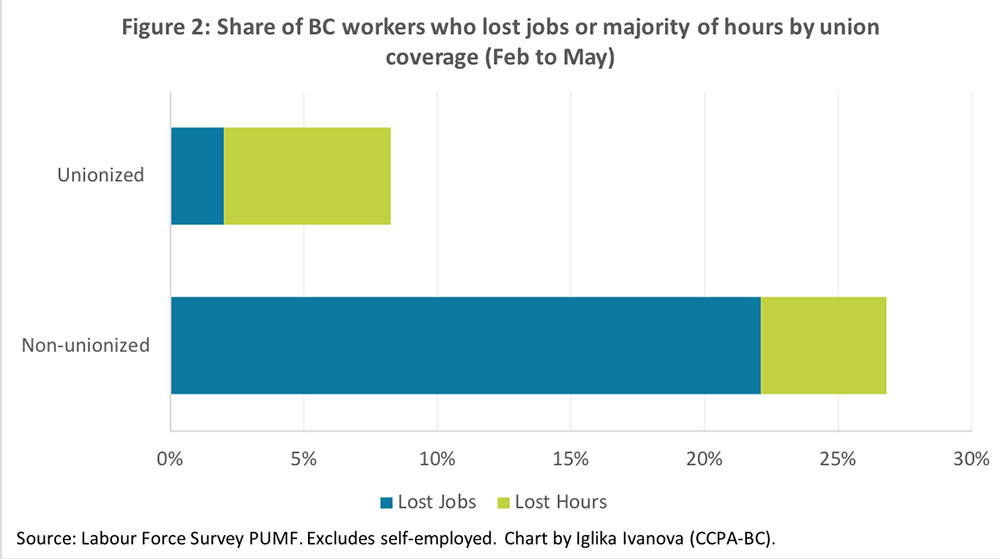
2. Non-unionized workers were much harder hit.
More than a quarter of non-unionized workers lost their jobs or the majority of their hours compared to only eight per cent of unionized workers. Unionized workers were also much more likely to see reductions in hours than outright job losses.
This is hardly surprising since unionization and collective bargaining tends to offer better workplace protections, and the hardest-hit sectors have lower unionization rates. Expanding access to unionization for lower-paid, precarious workers could improve job security and protections to B.C.’s most vulnerable workers and should be a key plank of the recovery.
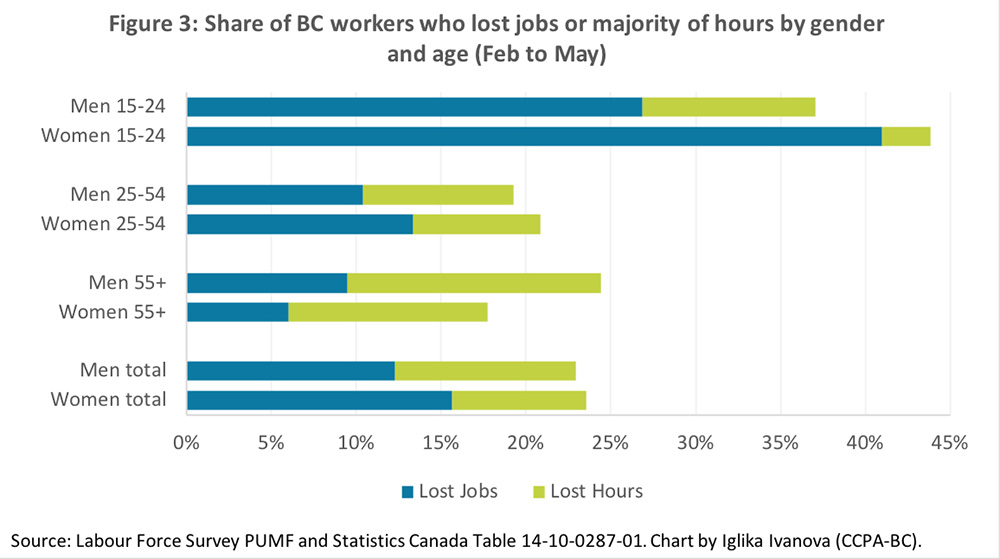
3. Young workers, particularly young women, saw staggering job losses.
Workers under 25 in B.C. were three times as likely as workers aged 25 to 54 to suffer job losses, with one in three young worker jobs (34 per cent) evaporating between February and May.
However, the average job loss among youth hides enormous gender differences. Young women under 25 experienced by far the worst job losses with a 41-per-cent drop in employment compared to 27 per cent for their male peers.
The COVID-19 recession has been dubbed a she-cession because women were much more likely than men to lose their job in March. While layoffs among men caught up in April, men have seen a faster jobs recovery in May.
In B.C., women saw a 16-per-cent decline in employment between February and May compared to a decline of 12 per cent for men. Further, women were more likely to lose their jobs, whereas men were more likely to have the majority of their hours cut while remaining employed. This difference was particularly pronounced among younger workers.
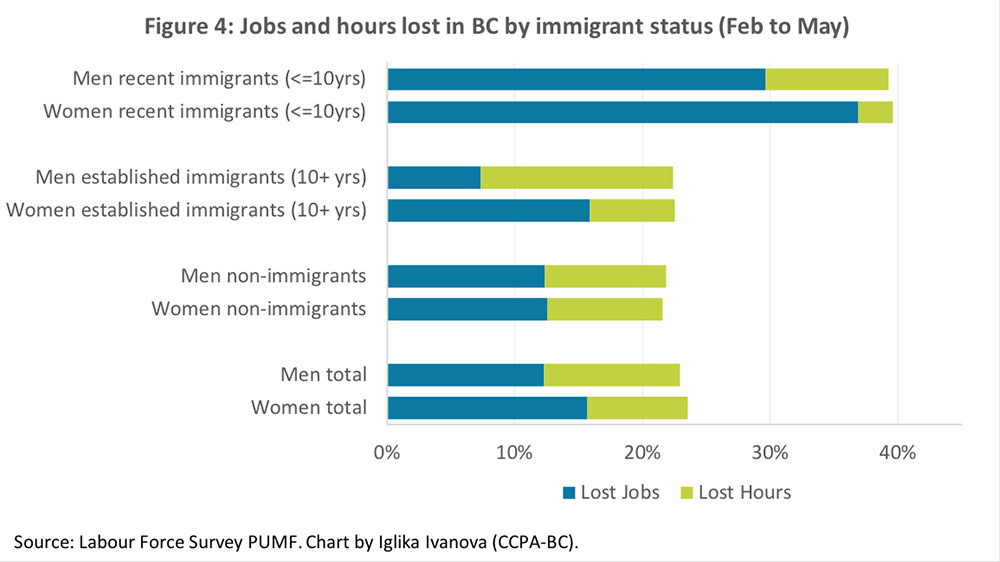
4. One in three recent immigrants lost their job.
Among recent immigrants in B.C. — those who have had permanent resident status in Canada for less than 10 years—the magnitude of job losses was nearly three times as high as those experienced by more established immigrants and non-immigrants. Immigrant women were more likely to lose their jobs than immigrant men, who were more likely to experience cuts in their hours but keep their jobs.
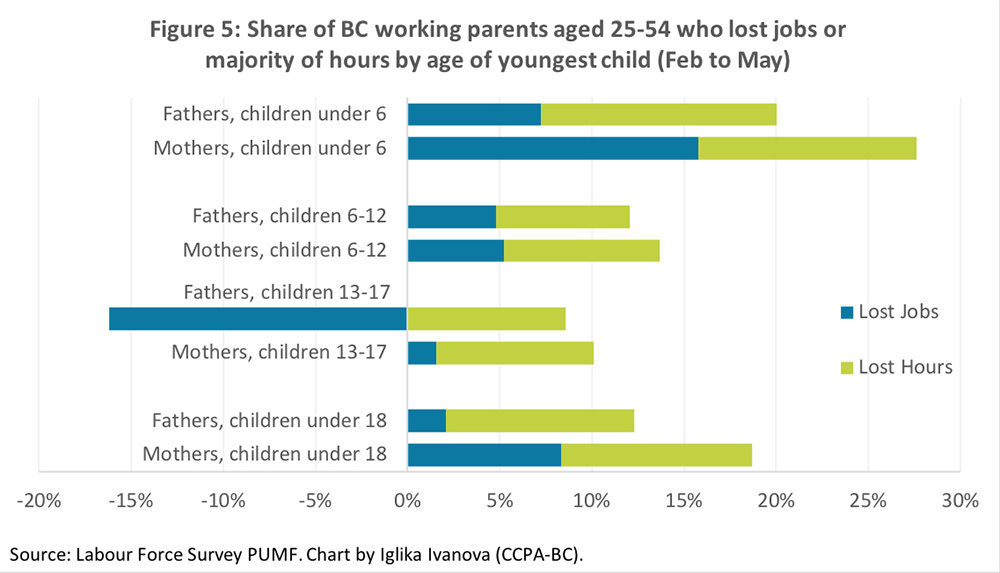
5. Mothers saw significantly larger job losses than fathers, especially those with young children.
School and child-care closures during the pandemic have imposed additional challenges for workers with children.
Among working parents 25 to 54, those with children under six were much more likely to experience losses in jobs and hours — mothers in particular. (Working parents make up about 43 per cent of the total B.C. workforce aged 25 to 54.)
Although the government introduced job-protected unpaid leave for parents who needed to care for their children while schools and child-care providers were closed, a significant share of mothers with children under six working in February appear to have lost their jobs (16 per cent).
In addition, parents of younger children were more likely to have lost the majority of their hours than their peers.
Going into the pandemic, women in B.C. already had a lower workforce participation rate than men and the gap was largest for women with children under six due to the lack of access to quality, affordable child care in our province.
Prioritizing safe and accessible child care for working parents over the summer and fall is essential if we are going to rebuild the province’s economy and ensure young families can weather the recession.
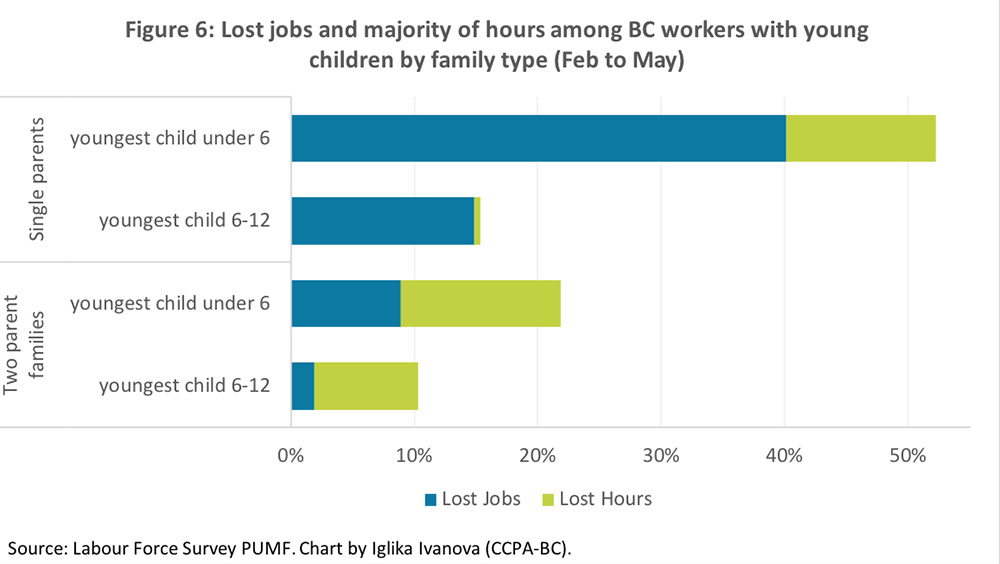
6. Single parents with young children were even harder hit.
Half of B.C.’s working single parents with children under six lost their jobs or hours. This group was small to begin with due to lack of affordable child-care spaces. Not surprisingly, single parents were much more likely to experience job losses than those in two-parent families where child care responsibilities can be shared.
Children in single-parent families are already at much higher risk of poverty than their peers in two-parent families, and the gap is likely to grow unless B.C. makes significant investments in expanding access to safe, affordable child care. Even if most of B.C.’s unemployed single parents are receiving the CERB for now, it is not at all clear that they will qualify for employment insurance once CERB is phased out in the fall. Even if they do, their benefits may be too low to keep them out of poverty.
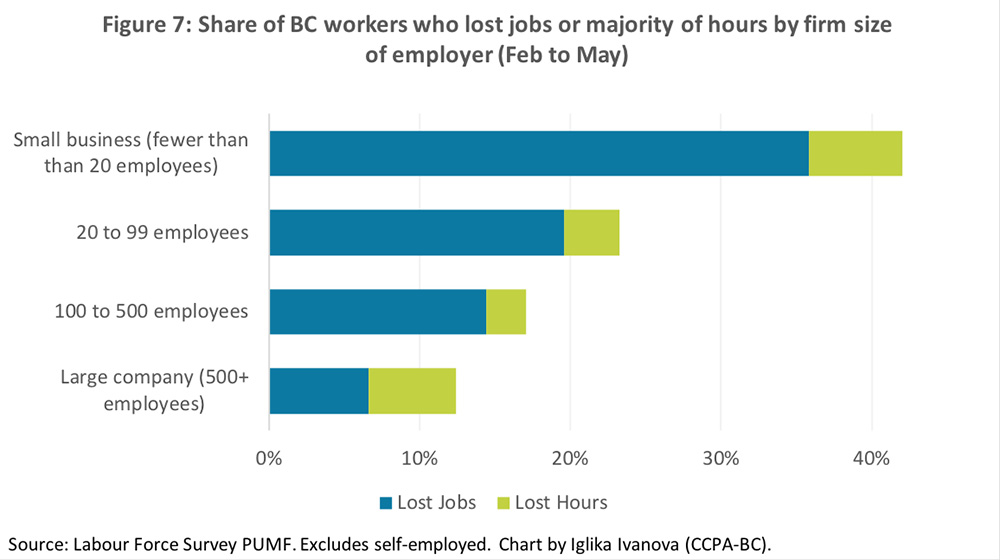
7. Workers in small businesses were more likely to lose their jobs.
Nearly half of all B.C. job losses between February and May were concentrated among those working for small employers (fewer than 20 staff), even though only 20 per cent of workers were employed by a small business.
This is hardly surprising. Small businesses and non-profit employers are less likely to have operational reserves to absorb the costs of pandemic closures or slowdowns — even with wage subsidies — and have been forced to lay off more of their workers than large corporations.
Not included in the chart above are self-employed workers. About half of B.C.’s self-employed workers are unincorporated and have no employees. This group reported very high losses in hours, with more than one in three losing the majority of their hours. It is critically important to continue monitoring the jobs recovery for this particularly vulnerable group of workers as the CERB is phased out, because they will not qualify for existing employment insurance programs.
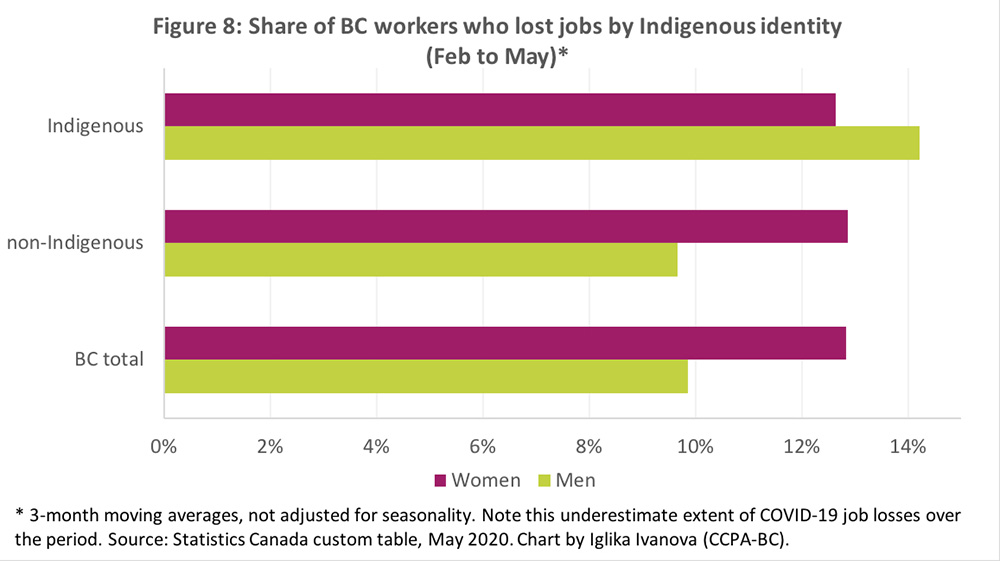
8. Indigenous men are more likely to have lost jobs.
Statistics about job loss among Indigenous workers are only available in the form of three-month moving averages, and there’s no data on reduced hours. But comparing the average employment numbers for March, April and May with those from December, January and February can help us pinpoint which groups and regions were hit harder by the job market losses, although these numbers should be viewed with some caution.
Indigenous workers were slightly more likely to lose their jobs than non-Indigenous workers in B.C., particularly Indigenous men. Indigenous and non-Indigenous women experienced similar rates of job loss, higher than non-Indigenous men. ![]()
Read more: Coronavirus, Labour + Industry




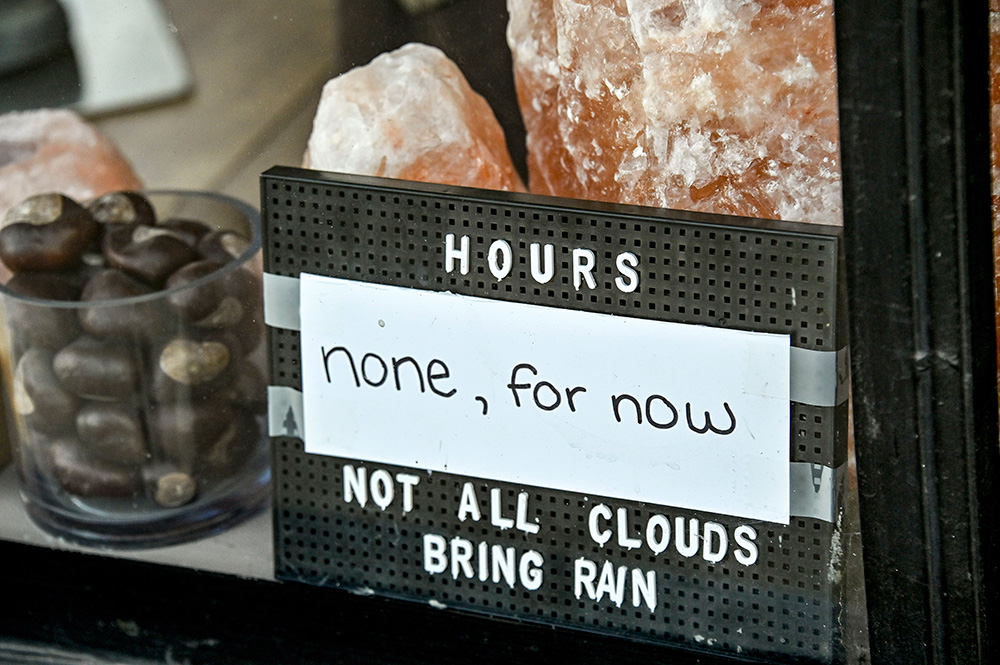












Tyee Commenting Guidelines
Comments that violate guidelines risk being deleted, and violations may result in a temporary or permanent user ban. Maintain the spirit of good conversation to stay in the discussion.
*Please note The Tyee is not a forum for spreading misinformation about COVID-19, denying its existence or minimizing its risk to public health.
Do:
Do not: